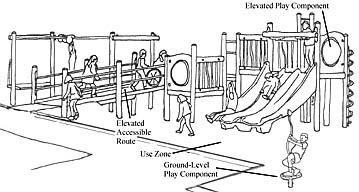Play Area Terms
Many terms are used throughout this guide to describe the play area guidelines. Familiarity with these terms is important when applying the guidelines. Other definitions are provided in the ADA and ABA Accessibility Guidelines.
ABA - Architectural Barriers Act.
Access Board - An independent Federal agency that develops accessibility guidelines under the ADA and other laws. The Access Board is also known as the Architectural and Transportation Barriers Compliance Board.
Accessible - Describes a site, building, facility, or portion thereof that complies with the play area guidelines.
Accessible Route - A continuous unobstructed path connecting all accessible elements and spaces of a building or facility. Inside the boundary of the play area, accessible routes may include platforms, ramps, elevators, and lifts. Outside the boundary of the play area, accessible routes may also include parking access aisles, curb ramps, crosswalks at vehicular ways, walks, ramps, and lifts.
ADA - Americans with Disabilities Act.
Alteration - An alteration is a change to a building or facility that affects or could affect the usability of the building or facility or part thereof. Alterations include, but are not limited to, remodeling, renovation, rehabilitation, reconstruction, historic restoration, resurfacing of circulation paths or vehicular ways, changes or rearrangement of structural parts or elements, and changes or rearrangement in the plan configuration of walls and full-height partitions. Normal maintenance is not an alteration unless it affects the usability of the facility (see section on alterations for more details).
Amusement Attraction - Any facility, or portion of a facility, located within an amusement park or theme park, that provides amusement without the use of an amusement device. Examples include, but are not limited to, fun houses, barrels, and other attractions without seats.
ASTM - American Society for Testing and Materials.
Berm - A sloped surface at ground level designed to ascend or descend in elevation.
Clear - Unobstructed.
Composite Play Structure - Two or more play structures attached or functionally linked, to create one integral unit that provides more than one play activity (ASTM F 1487-01).
Cross Slope - The slope that is perpendicular to the direction of travel (see running slope).
Elevated Play Component - A play component that is approached above or below grade and that is part of a composite play structure consisting of two or more play components attached or functionally linked to create an integrated unit providing more than one play activity.
Facility - All or any portion of buildings, structures, site improvements, elements, and pedestrian routes or vehicle ways located on a site
Ground Level Play Component - A play component that is approached and exited at the ground level.
Play Area - A portion of a site containing play components designed and constructed for children.
Play Component - An element intended to generate specific opportunities for play, socialization, or learning. Play components may be manufactured or natural, and may be stand alone or part of a composite play structure.
Ramp - A walking surface that has a running slope of greater than 1:20.
Running Slope - The slope that is parallel to the direction of travel (see cross slope).
Site - A parcel of land bounded by a property line or a designated portion of a public right-of-way.
Soft Contained Play Structure - A play structure made up of one or more components where the user enters a fully enclosed play environment that utilizes pliable materials (e.g., plastic, netting, fabric).
Use Zone - The ground level area beneath and immediately adjacent to a play structure or piece of equipment that is designated by ASTM F 1487 Standard Consumer Safety Performance Specification for Playground Equipment for Public Use for unrestricted circulation. This is the play surface upon which it is predicted a user would land when falling from or exiting the equipment.


User Comments/Questions
Add Comment/Question